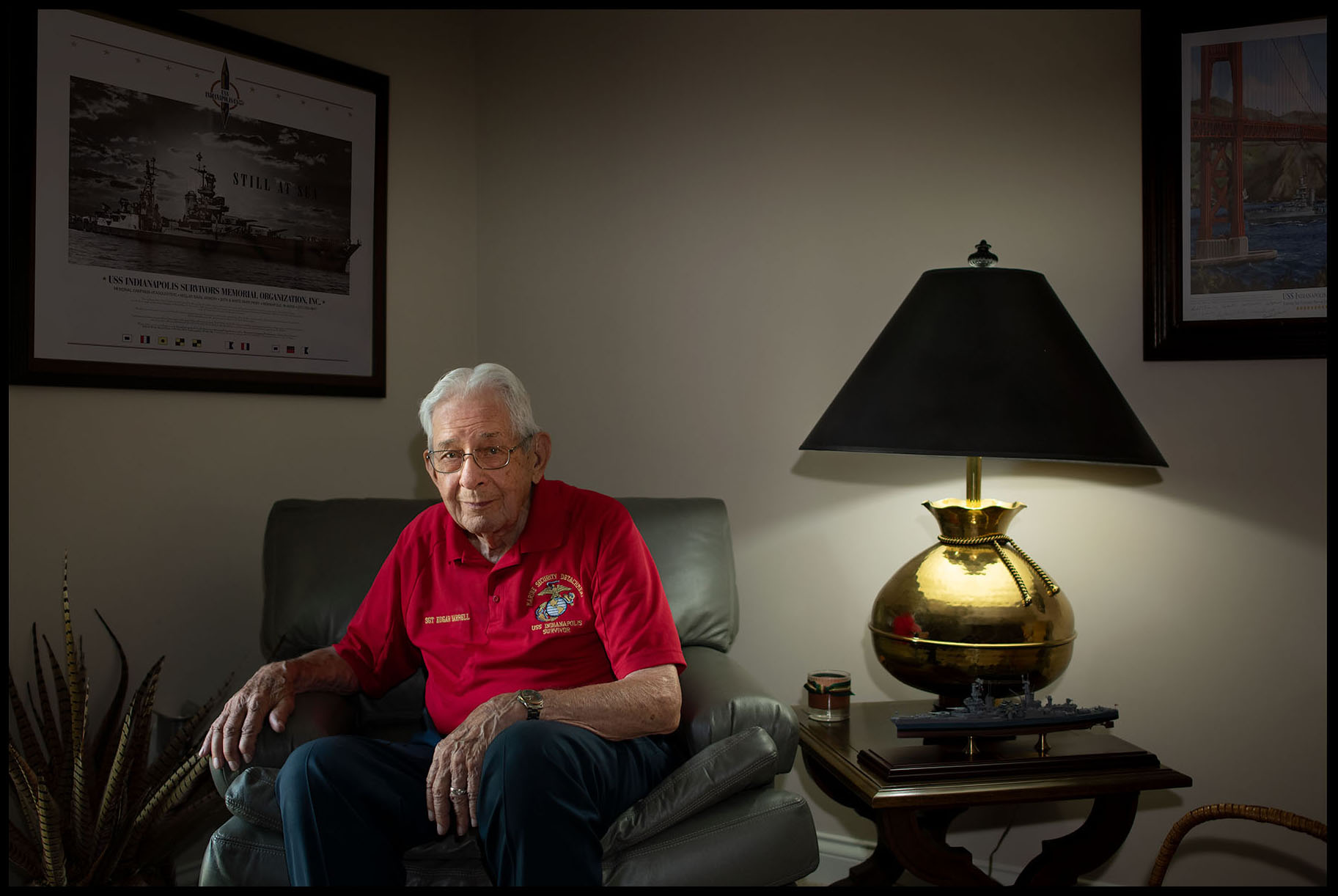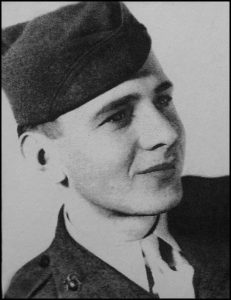
Edgar Harrell
Last Marine survivor
of USS Indianapolis sinking
Edgar Harrell
Sergeant, USMC
1943–1946

Pvt. Edgar Harrell
San Diego, CA, 1943
I am the last Marine survivor of the sinking of the USS Indianapolis. It is much easier to die than live. You’ve got to struggle to live. I had something to live for—my family and a little brunette named Ola Mae who said she’d wait for me. We were married for 71 years.
I was born in 1924 in Kentucky. I knew I was gonna be a Marine and joined in 1943. I boarded the USS Indianapolis in early 1944. My first combat experience was at Kwajalein and Eniwetok. Then we saw combat in Saipan, Tinian, Guam, Battle of the Philippine Sea, Peleliu, Iwo Jima, and Okinawa. I’ve got seven of the ten battle stars of the Indianapolis.
In Okinawa we were hit by a kamikaze and went to San Francisco for repairs. They put a large container aboard. We found out later it was atomic bomb components and uranium. We left for Tinian on July 16, 1945. We delivered our cargo, then headed to Guam. The captain asked for an escort. They said we didn’t need one. They knew Japanese submarines were in those waters but they didn’t tell him. We got underway July 29th. My Marine top sergeant told me I just made sergeant. No plane came in to pick up our mail, so my sergeant rating didn’t go through, but I got it recently. I just waited 75 years.
It was hot and we were given permission to sleep on the open deck. Japanese Submarine Commander Hashimoto was tracking our ship. The first torpedo hit 40 feet in front of me, cutting off the bow of the ship. The second one caused a massive fire. Men came from below deck, screaming with scorched flesh. The word came to abandon ship. I looked over the edge at all the oil on the water and held onto that rail, pleading with God. As we abandoned ship, I heard Him say, “I will not abandon you.” I went in the water feet first and swam to a group of about 80 boys.
I found two Marines. One was a new boy we picked up in Pearl. He died in my arms. Fifty years later I got a call asking if I knew Leland Hubbard. I said no, but they sent me his picture. I broke down and cried. I told his family he was the Marine who died in my arms. That’s what they needed to hear. The other Marine was my friend Spooner. I was his squad leader. That first night we lost several boys. At daylight, we saw fins. We formed a circle and tried to keep everyone in. Some guys strayed off. You’d hear a blood-curdling scream and see him go under. He would come back to the surface but you’d see fins and realize his legs were gone, or he just had a torso.
Second Day
We were desperate for water and were told not to drink the salt water because it affects the brain. Some would drink it and within the hour their minds were going. Our group dwindled to about 40 the second day.
Third Day
At noon there were only 17 of us. Bodies floated up so swollen and bloated you couldn’t recognize them. We came upon five sailors around a raft with extra life jackets. Spooner, and I joined them. I noticed a crate in the water. They were half-rotten potatoes and we had a little picnic. That night we met up with Lieutenant McKissick and five boys.
Fourth Day
At daybreak I’m with McKissick and one sailor, but we had lost the raft and the others. No one was looking for us. Then we saw a plane a few thousand feet up. We yelled and waved. He saw the oil slick and debris and radioed Peleliu. A PBY plane arrived and picked up 56 stragglers. I met back up with Spooner.
The Doyle came that night and got us. I was covered with oil and they gave me a kerosene bath. They got the rotten flesh off me and wrapped me in Vaseline gauze. At a hospital in Guam, Admiral Spruance pinned the Purple Heart on me. That’s where we found out what our cargo was. We lost 880 shipmates. Only 317 of us survived the four days.
It is much easier to die than live. You’ve got to struggle to live. I had something to live for—my family and a little brunette named Ola Mae who said she’d wait for me. We were married for 71 years. {10-03-1019 • Clarksville, TN}